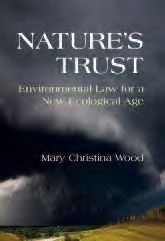SEJournal Online is the digital news magazine of the Society of Environmental Journalists. Learn more about SEJournal Online, including submission, subscription and advertising information.

BookShelf
"Nature’s Trust: Environmental Law for a New Ecological Age"
By Mary Christina Wood
Cambridge University Press, $45.00
Reviewed by JAY LETTO
“Ain’t no use jiving. Ain’t no use joking. Everything is broken.”
If you’ve been covering environmental legal cases, or the lack of enforcement of countless environmental rules and regulations by the feds, states and local governments, then you already should know the Dylan song rings true for environmental law.
Author Mary Wood pulls no punches while going into great detail about the systemic dysfunctional enforcement of environmental laws within all branches and all levels of government. Wood blends an enduring sense of place with her broad knowledge of environmental law and its shortcomings to put forward nothing short of an entirely revamped environmental legal system that might just help the world prepare for a climate-changed future.
Wood’s sense of place comes from growing up alongside a small stream that empties into the Columbia River east of Vancouver, WA. SEJers toured her place in October 2001 to see salmon spawning.
In the Pacific Northwest, Native Americans still hold significant rights to traditional fishing sites and to the fish themselves, but even this is not a given, as sports fishers and commercial fishers cry foul.
For Wood it does count. Indeed, when most white settlers were grabbing all the land they could, Wood’s great-grandfather, C.E.S. Wood, befriended Chief Joseph of the Nez Perce, then resigned from the Army and worked to help the Nez Perce get some of their land back. His son Erskine, Wood’s grandfather, even went to live with Joseph, and later published a diary about the experience, “Days With Joseph.”
So Wood grew up steeped in stories of Native Americans and gained a deep respect for the “rooted land traditions of the Nez Perce.” She watched every year as salmon faithfully returned to her childhood stream.
She experienced sustainability in ecological systems as a child, and learned how indigenous people’s connections to the land sustain the resources — an approach she refers to as managing for “abundance” in the future, as opposed to managing for “scarcity,” which is how she generally describes the modern regimen of environmental laws.
Wood’s knowledge of environmental law comes from decades of practice, teaching and research in her native Pacific Northwest, where she has witnessed firsthand the tragic shortcomings of our environmental laws and the agencies charged with enforcing them.
She combines this knowledge with her deep understanding of Indian law — she has become a leading scholar on Indian treaty rights — to set in motion a whole new way of thinking about environmental law. That is, actual protection for the environment, and not, as Wood would say, sanctioned destruction for a small fee.
In this ambitious book, the author proposes a combination of public trust law and indigenous natural law. Wood would have a tripartite structure involving the tribes, feds and states jointly overseeing environmental and natural resource law.
The time is ripe to read this book, as next year’s SEJ conference will be in Norman, OK, where one of the main issues we’ll explore is how Native Americans are flexing their legal muscles on land-use laws and water rights across the country.
Jay Letto is SEJ’s conference director. He lives in White Salmon, Washington.
* From the quarterly newsletter SEJournal, Fall 2014. Each new issue of SEJournal is available to members and subscribers only; find subscription information here or learn how to join SEJ. Past issues are archived for the public here.













 Advertisement
Advertisement 




